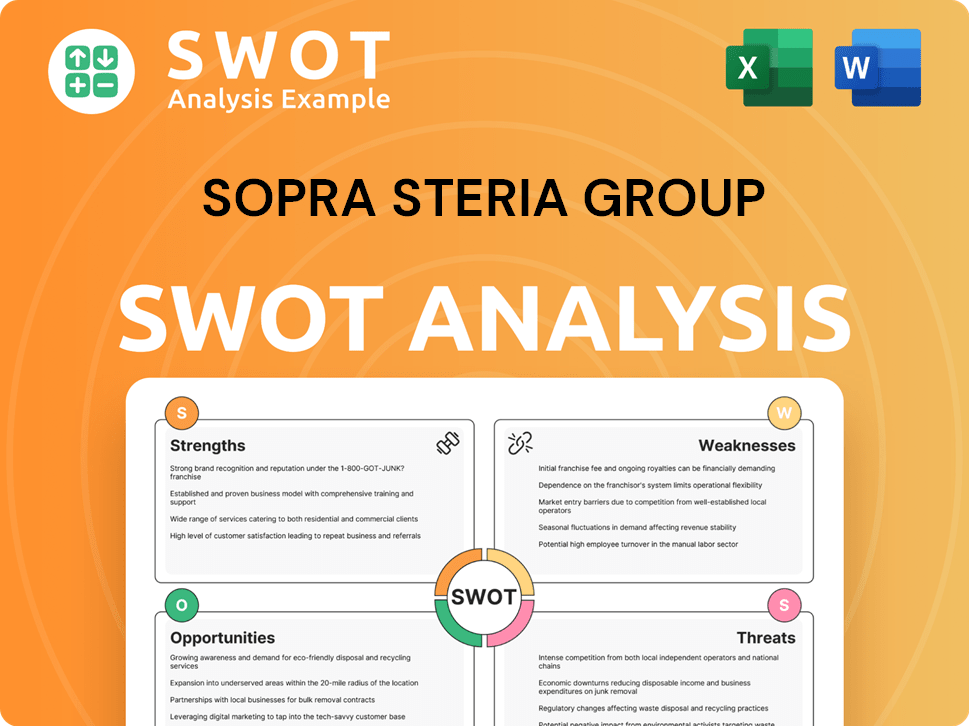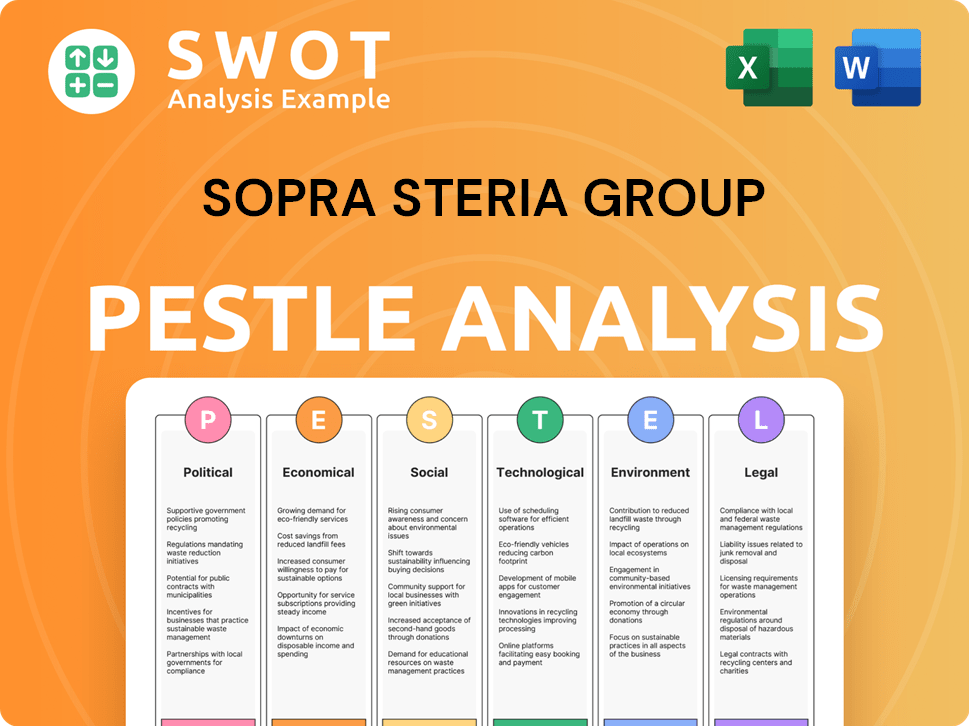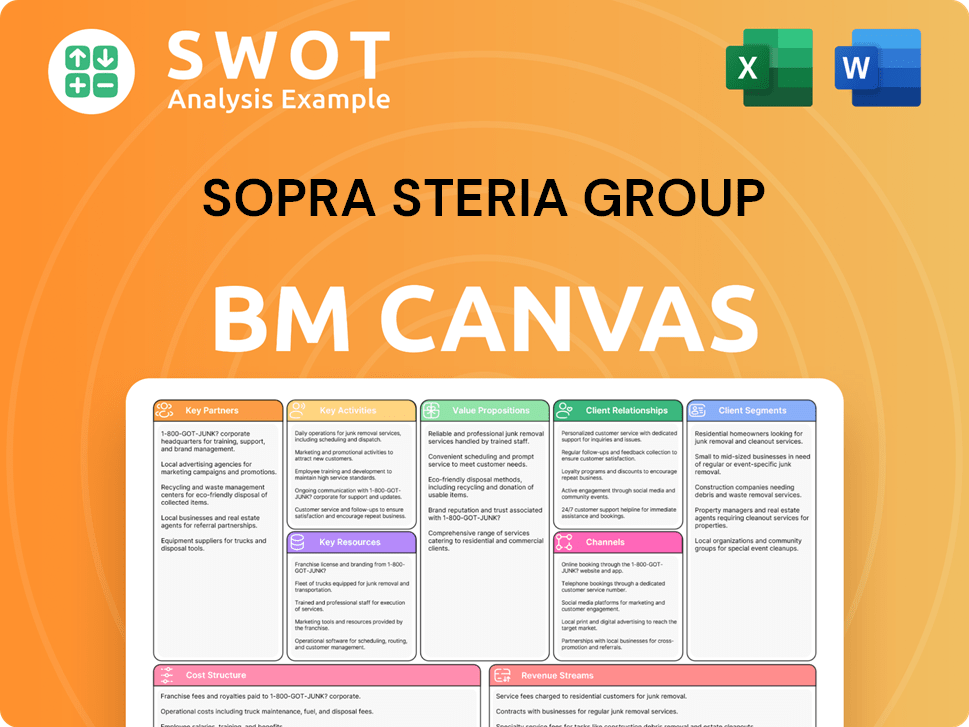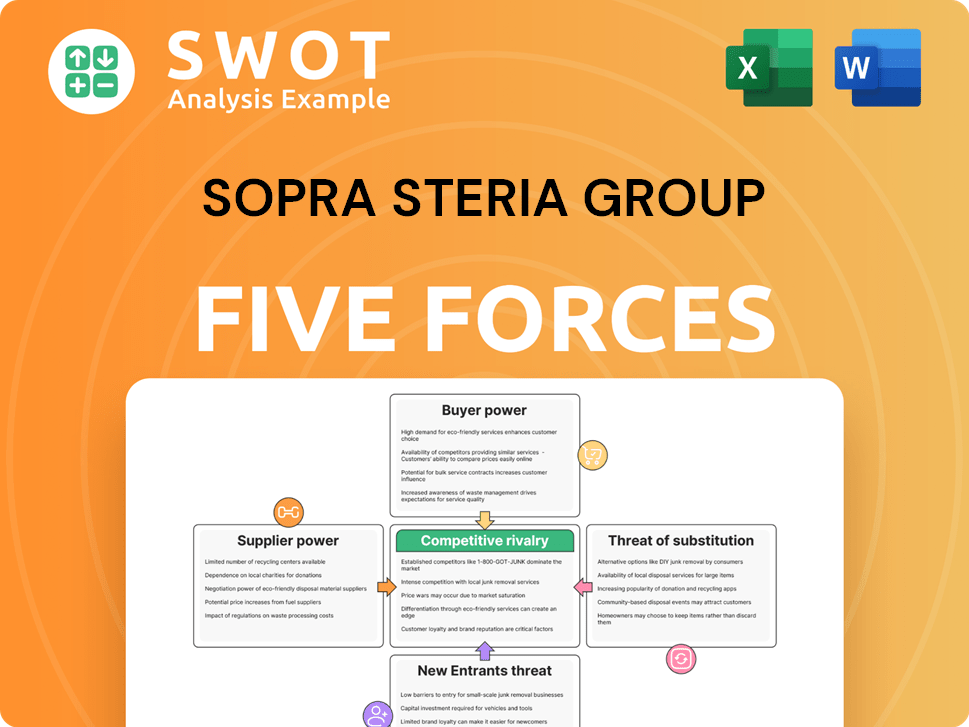Sopra Steria Group Bundle
How Does Sopra Steria Navigate the Cutthroat IT Services Arena?
In the fast-paced world of digital transformation, understanding the Sopra Steria Group SWOT Analysis is crucial. Sopra Steria, a major player in IT consulting and digital services, constantly adapts to industry shifts. This analysis explores the firm's competitive positioning, key rivals, and strategic advantages within the ever-evolving IT services industry.

This exploration of the Sopra Steria competitive landscape will provide a comprehensive market analysis, examining its strengths and weaknesses against its competitors. We'll delve into Sopra Steria's service offerings, geographic presence, and acquisition strategies to understand its impact on the IT services industry. Furthermore, we'll analyze Sopra Steria's financial performance and future growth strategies, including its challenges and opportunities in the digital transformation era, comparing it with key rivals like Capgemini.
Where Does Sopra Steria Group’ Stand in the Current Market?
Sopra Steria holds a strong market position within the European IT consulting and digital services industry. The company is known for providing end-to-end solutions, combining business knowledge with expertise in innovative technologies. This approach allows it to cater to the needs of large organizations effectively. Sopra Steria's core operations revolve around helping clients modernize their operations and adopt new technologies, which is crucial in today's rapidly evolving market.
The company's value proposition lies in its ability to deliver comprehensive services across consulting, systems integration, infrastructure management, and business process services. This broad range of services enables Sopra Steria to meet diverse client needs, from strategy to execution. Its focus on digital transformation helps clients stay competitive by leveraging the latest technological advancements. A deeper dive into the Marketing Strategy of Sopra Steria Group provides further insights.
Sopra Steria's geographic presence is significant, with strong footholds in key European markets. Its diverse customer segments include public sector, defense, financial services, aerospace, and telecommunications. This broad client base helps Sopra Steria maintain a robust market position and adapt to changing industry dynamics.
In 2023, Sopra Steria reported revenue of €5.8 billion, demonstrating its substantial scale within the IT services industry. This financial performance positions it as a major player in the European market. This revenue figure is a key indicator of its market share and competitive standing.
Sopra Steria offers a wide range of services, including consulting, systems integration, and business process outsourcing. These services support clients through their digital transformation journeys. The company's comprehensive service portfolio allows it to address various client needs effectively.
Sopra Steria has a strong presence across Europe, with significant operations in France, the UK, Germany, and Scandinavia. This broad geographic footprint enables it to serve a diverse client base. Its strategic locations support its competitive positioning in the IT services industry.
The company serves a diverse range of customer segments, including public sector, defense, financial services, aerospace, and telecommunications. This diversification helps mitigate risks and ensures a broad market reach. Sopra Steria's focus on these key industries contributes to its market position.
The Sopra Steria competitive landscape is characterized by strong competition from other major IT service providers. Key rivals include Capgemini, Atos, and Accenture. Understanding the Sopra Steria competitors is crucial for assessing its market position. A detailed Sopra Steria market analysis reveals its strengths and weaknesses in relation to these competitors.
- Digital Transformation: Sopra Steria's focus on digital transformation is a key strength, allowing it to help clients modernize their operations.
- Geographic Footprint: Its strong presence in key European markets provides a competitive advantage.
- Service Portfolio: The comprehensive range of services, from consulting to outsourcing, enables it to meet diverse client needs.
- Financial Performance: The €5.8 billion revenue in 2023 highlights its substantial scale and market presence.
Sopra Steria Group SWOT Analysis
- Complete SWOT Breakdown
- Fully Customizable
- Editable in Excel & Word
- Professional Formatting
- Investor-Ready Format

Who Are the Main Competitors Challenging Sopra Steria Group?
The Sopra Steria competitive landscape is shaped by a dynamic interplay of global and regional players. The IT services industry is fiercely contested, with companies vying for market share in digital transformation, business process outsourcing, and other key areas. Understanding the Sopra Steria competitors and their strategies is crucial for assessing its position and future prospects.
Sopra Steria market analysis reveals a landscape where both direct and indirect competitors challenge its operations. Direct competitors offer similar services, while indirect competitors may focus on niche areas or employ disruptive business models. This competitive environment necessitates continuous innovation and strategic adaptation.
Direct competitors include major IT services firms such as Capgemini, Atos, Accenture, and CGI. These companies offer a broad range of services and often compete for the same clients and projects. They challenge Sopra Steria through their global presence, service offerings, and pricing strategies.
Indirect competition comes from specialized boutique consulting firms, in-house IT departments, and emerging technology startups. These players often focus on niche areas like AI, cloud computing, or cybersecurity, offering specialized solutions that can disrupt traditional service models. They can be agile and innovative.
Key competitive factors include pricing, innovation in emerging technologies, brand recognition, and the ability to attract and retain top talent. Extensive global delivery networks and successful acquisition strategies also play a significant role. These factors influence a company's ability to secure contracts and maintain a competitive edge.
The IT services industry is subject to consolidation through mergers and acquisitions. This can alter the competitive landscape by creating larger, more diversified entities. These changes can significantly impact market share and competitive positioning. The industry is constantly evolving.
Sopra Steria's geographic presence is primarily focused on Europe, which means it faces strong competition from European-based firms like Atos. However, it also competes with global players like Accenture, which have a wider reach. This geographic focus influences its competitive positioning.
Comparing Sopra Steria's financial performance with its competitors provides insights into its market position. Factors such as revenue growth, profitability, and market share are critical. Analyzing these metrics helps assess the company's competitiveness. For instance, comparing revenue growth rates can reveal which companies are gaining ground in the market.
For a deeper understanding of the company's history and evolution, consider reading the Brief History of Sopra Steria Group. This background provides context for its current competitive position.
Sopra Steria's strengths and weaknesses compared to competitors are crucial for understanding its market position. Its ability to innovate and adapt to changing market demands is essential. The company faces numerous challenges, including intense competition, the need to attract and retain skilled professionals, and the rapid evolution of technology.
- Strengths: Strong presence in Europe, focus on digital transformation, established client base.
- Weaknesses: Dependence on the European market, potential vulnerability to economic downturns in the region, and competition from larger global players.
- Challenges: Maintaining profitability in a competitive market, keeping pace with technological advancements, and managing costs.
- Opportunities: Expanding into new markets, acquiring innovative companies, and developing new service offerings.
Sopra Steria Group PESTLE Analysis
- Covers All 6 PESTLE Categories
- No Research Needed – Save Hours of Work
- Built by Experts, Trusted by Consultants
- Instant Download, Ready to Use
- 100% Editable, Fully Customizable

What Gives Sopra Steria Group a Competitive Edge Over Its Rivals?
The competitive advantages of Sopra Steria Group are rooted in its deep industry expertise, comprehensive service offerings, and strong presence in the European market. This combination allows the company to provide tailored solutions that address complex client challenges, setting it apart from competitors. Sopra Steria's focus on critical and sensitive projects further solidifies its relationships with large organizations, building a strong barrier to entry for new rivals.
Sopra Steria's ability to combine in-depth business knowledge with innovative technologies is a key differentiator. This integrated approach, spanning consulting, digital services, and software development, allows it to offer end-to-end solutions. The company's long-standing relationships with major clients, particularly in the public sector and defense, showcase a high level of trust and client loyalty.
Furthermore, Sopra Steria's robust European footprint gives it a significant edge. This allows it to effectively cater to the specific regulatory and cultural nuances of the European market. Investments in R&D, especially in areas like cybersecurity, cloud, and AI, ensure its offerings remain cutting-edge. The company's skilled talent pool is another key asset, enabling the delivery of complex, high-value projects.
Sopra Steria's deep understanding of various industries allows it to offer highly tailored solutions. This expertise is crucial in addressing the complex needs of clients across different sectors. The company's ability to combine business knowledge with innovative technologies is a key differentiator in the IT services industry.
The company's strong presence in Europe provides a significant advantage, allowing it to effectively serve the specific needs of the European market. This regional focus enables Sopra Steria to navigate regulatory and cultural nuances more effectively than some global competitors. This competitive positioning is crucial for sustained growth.
Sopra Steria has built long-standing relationships with major clients, particularly in the public sector and defense. These relationships are built on trust and reliability, creating a barrier to entry for new competitors. The focus on critical projects further solidifies these client relationships.
Investment in research and development, particularly in areas like cybersecurity, cloud, and AI, ensures Sopra Steria's offerings remain at the forefront of technological innovation. This commitment to innovation is crucial in a rapidly evolving digital landscape. The company's focus on emerging technologies drives its competitive advantage.
Sopra Steria's competitive advantages are multifaceted, encompassing industry expertise, technological innovation, and a strong European presence. These strengths enable the company to deliver tailored solutions and maintain strong client relationships. Understanding these advantages is crucial for a comprehensive Sopra Steria competitive landscape analysis.
- Deep industry knowledge and tailored solutions.
- Strong presence in the European market.
- Long-standing client relationships and loyalty.
- Continuous investment in research and development.
- Highly skilled talent pool.
Sopra Steria Group Business Model Canvas
- Complete 9-Block Business Model Canvas
- Effortlessly Communicate Your Business Strategy
- Investor-Ready BMC Format
- 100% Editable and Customizable
- Clear and Structured Layout

What Industry Trends Are Reshaping Sopra Steria Group’s Competitive Landscape?
The IT consulting and digital services sector is dynamic, with the competitive landscape of Sopra Steria Group evolving due to technological advancements and shifting client demands. A comprehensive Sopra Steria market analysis reveals that the company faces both challenges and opportunities in this environment. Understanding the industry trends, future challenges, and opportunities is crucial for assessing Sopra Steria's competitive position and future prospects.
The company operates within a market characterized by intense competition and rapid change. To stay competitive, Sopra Steria must continuously adapt its strategies and offerings. The following sections will explore the key industry trends, potential challenges, and growth opportunities that shape the competitive landscape of Sopra Steria.
The IT services industry is currently experiencing significant shifts. Digital transformation initiatives, including cloud computing, AI, and ML, are driving growth. Cybersecurity solutions are increasingly in demand due to rising cyber threats. The push for digital sovereignty, particularly in Europe, is also a key trend.
Sopra Steria faces challenges such as rapid technological advancements in AI and ML, requiring continuous investment in R&D. Stricter data privacy laws and regulations necessitate service adaptations. Competition from established players and new entrants also presents a significant hurdle.
There are significant growth opportunities for Sopra Steria. The need for cybersecurity solutions offers a substantial market. Digital transformation initiatives by large organizations continue to drive demand for consulting and integration services. Emerging markets provide avenues for geographical expansion.
Sopra Steria is well-positioned to leverage its comprehensive service portfolio and industry knowledge. The company's focus on sustainable and responsible digital solutions aligns with growing client and societal expectations. Strategic partnerships and AI capabilities are key to maintaining a competitive edge.
The IT services industry is experiencing rapid growth, with a global market size expected to reach approximately $1.4 trillion in 2024, according to Gartner. The increasing adoption of cloud computing is a major driver, with cloud services spending projected to grow by 20.7% in 2024. Cybersecurity spending is also on the rise, with forecasts indicating a growth of over 11% in 2024. These trends create both opportunities and challenges for companies like Sopra Steria.
- Cloud Computing: The shift to cloud services presents opportunities for Sopra Steria to offer cloud migration and management services.
- Cybersecurity: Rising cyber threats increase the demand for robust cybersecurity solutions, where Sopra Steria can expand its offerings.
- Digital Transformation: Organizations are investing heavily in digital transformation, creating a need for consulting and integration services.
- AI and ML: The rapid advancement of AI and ML technologies requires continuous investment in R&D and talent acquisition.
- Data Privacy: Stricter data privacy laws necessitate adaptation of services to ensure compliance.
- Competition: The market is highly competitive, with established players and new entrants vying for market share. For more insights into the company's structure, you can read about the Owners & Shareholders of Sopra Steria Group.
Sopra Steria Group Porter's Five Forces Analysis
- Covers All 5 Competitive Forces in Detail
- Structured for Consultants, Students, and Founders
- 100% Editable in Microsoft Word & Excel
- Instant Digital Download – Use Immediately
- Compatible with Mac & PC – Fully Unlocked

Related Blogs
- What are Mission Vision & Core Values of Sopra Steria Group Company?
- What is Growth Strategy and Future Prospects of Sopra Steria Group Company?
- How Does Sopra Steria Group Company Work?
- What is Sales and Marketing Strategy of Sopra Steria Group Company?
- What is Brief History of Sopra Steria Group Company?
- Who Owns Sopra Steria Group Company?
- What is Customer Demographics and Target Market of Sopra Steria Group Company?
Disclaimer
All information, articles, and product details provided on this website are for general informational and educational purposes only. We do not claim any ownership over, nor do we intend to infringe upon, any trademarks, copyrights, logos, brand names, or other intellectual property mentioned or depicted on this site. Such intellectual property remains the property of its respective owners, and any references here are made solely for identification or informational purposes, without implying any affiliation, endorsement, or partnership.
We make no representations or warranties, express or implied, regarding the accuracy, completeness, or suitability of any content or products presented. Nothing on this website should be construed as legal, tax, investment, financial, medical, or other professional advice. In addition, no part of this site—including articles or product references—constitutes a solicitation, recommendation, endorsement, advertisement, or offer to buy or sell any securities, franchises, or other financial instruments, particularly in jurisdictions where such activity would be unlawful.
All content is of a general nature and may not address the specific circumstances of any individual or entity. It is not a substitute for professional advice or services. Any actions you take based on the information provided here are strictly at your own risk. You accept full responsibility for any decisions or outcomes arising from your use of this website and agree to release us from any liability in connection with your use of, or reliance upon, the content or products found herein.